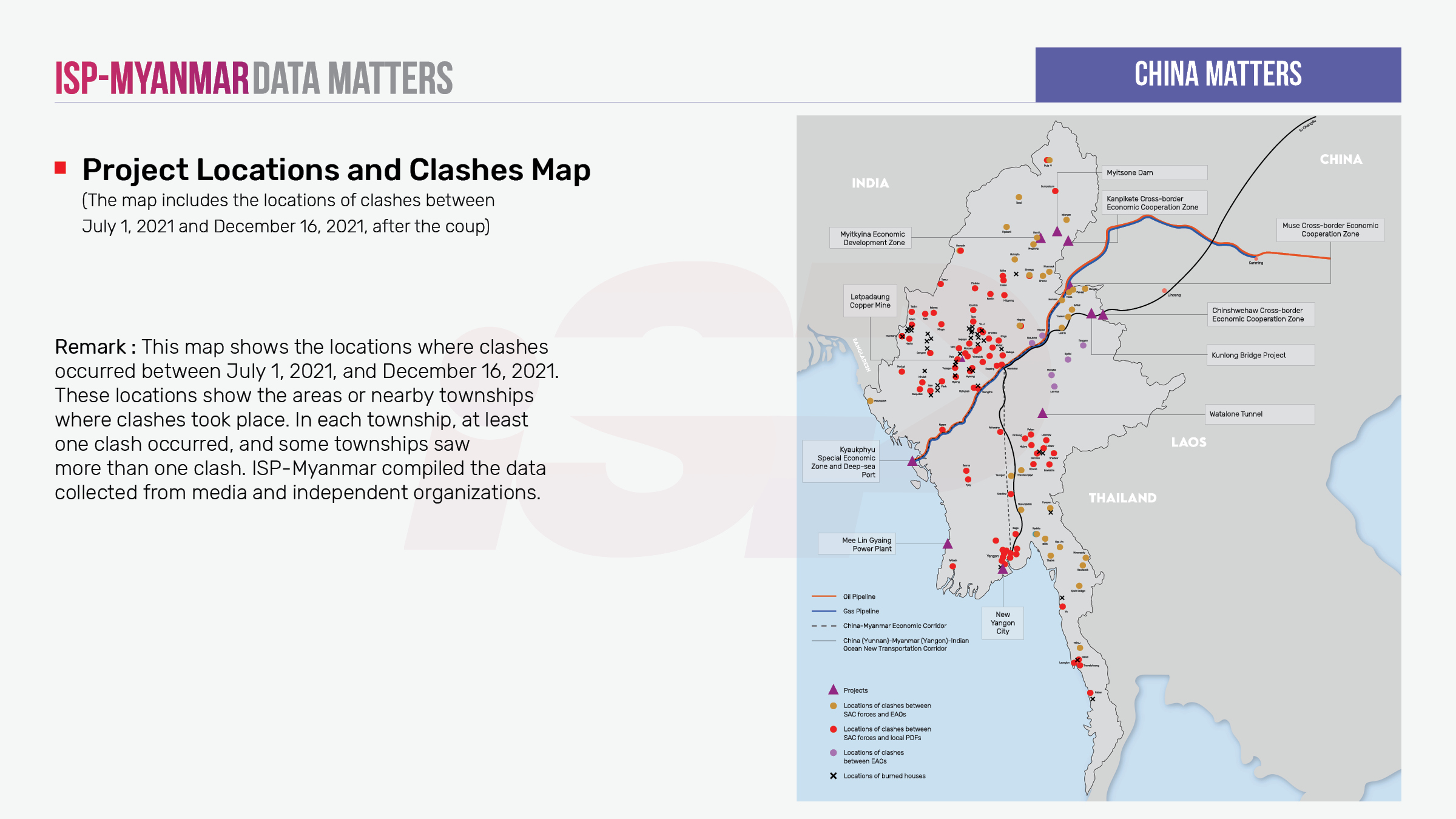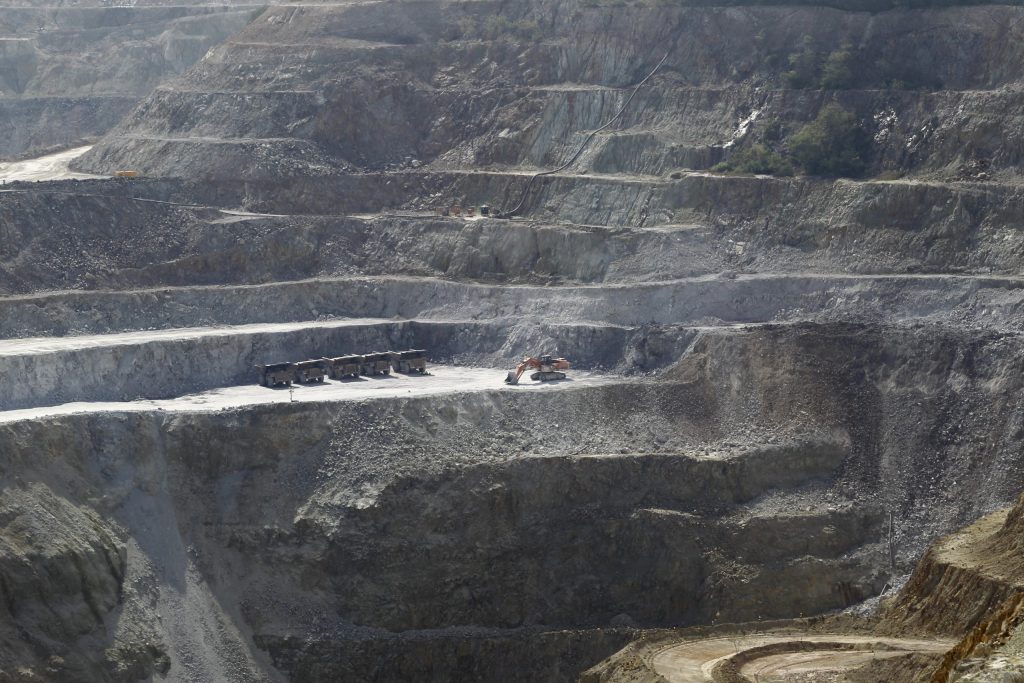ISP Mapping No. 1
(This article is a translation of the Burmese language version that ISP-Myanmar posted on its Facebook page on February 4, 2022).

Since before the military coup, the majority of strategic projects designed to boost activity in the China-Myanmar Economic Corridor have been implemented in ethnic minority areas where armed conflicts occur most frequently. In particular, border economic cooperation zone projects are mostly based in northern Shan State where at least 7 ethnic armed organizations (EAOs) are active, and where projects such as the construction of the Muse-Mandalay high-speed rail are planned to be built mostly through townships affected by armed clashes. Similarly, since the coup, Myanmar’s internal conflict map has expanded to incorporate escalating conflicts between State Administration Council (SAC) forces and Ethnic Armed Organizations (EAOs), between EAOs themselves, as well as the burgeoning conflict between SAC forces and the newly formed local defense forces (PDF/ LDF/ CDF/ KNDF etc.).
Since the coup, fighting over territorial control has escalated between two Shan ethnic armed organizations in northern Shan State: Restoration Council of Shan State (RCSS/SSA) and Shan State Progressive Party (SSPP/SSA). RCSS has recently lost control of muchits Shan State territory. This is largely due to the offensive military operations by SSPP with its allies Ta’ang National Liberation Army (TNLA) and United Wa State Army (UWSA), which are regarded as close to China. However, the territorial expansion of the Myanmar National Democratic Alliance Army (MNDAA) from Kokang has also been significant. Local People’s Defense Forces (PDFs) have also strengthened their numbers in townships where the China-backed Letpadaung Copper Mine and the Tagaung Nickel-Processing Plant are located.
∎ Attacks on Major China-Myanmar Projects
Although anti-China sentiment has gained momentum since the military coup, clashes near Chinese-backed economic projects have yet to have any major impact. During March 2021, 32 China clothing factories were set on fire; however, since China showed a tough attitude towards the event, no similar incident has since occurred. More recently, there was little impact despite attacks on guard forces of the China-Myanmar gas pipeline, the explosion in the China clothing factory at Pathein industrial zone, and the rocket-fire attack on the water pipeline for the Letpadaung Project. However, after the rocket-fire attack by Tigyaing PDF on 3 electric towers connected to the Tagaung Nickel-Processing Plant, China spoke directly with the National Unity Government (NUG) asking for China’s businesses and projects not to be attacked. During this communication, it is known that U Yi Mon, the Minister of Defense of the National Unity Government said that this incident was carried out by the autonomous decisions of on-the-ground troops and NUG would try to ensure that similar incidents would not happen again. It is also known that U Yi Mon stressed that interests and businesses of neighboring countries stay away from SAC forces.
According to data compiled by ISP-Myanmar, fighting broke out in Namhkan, Kutkai, Hseni, Lashio, Hsipaw and Kyaukme townships in northern Shan State where Chinese projects such as the Muse Border Economic Cooperation Zone, Muse-Mandalay high-speed rail line and the China-Myanmar oil and gas pipeline are located. A number of clashes have also been recorded between local PDFs and SAC forces in areas in Sagaing region, in townships which neighbor areas of China invested projects. How these clashes have had negligible impact on these China-backed economic projects can be observed in the map above.
∎ Why does it matter?
It is clear that the fighting that took place after the military coup, which involved the targeting of major Chinese projects could have a major impact on China’s general and economic policy considerations for Myanmar; China’s response may vary depending on the emerging resistance forces, such as the PDFs, within Myanmar. It is particularly important to observe the military operations of the EAOs in Shan State, the focal point of Chinese economic and infrastructure projects, and especially the situation along the China-Myanmar Economic Corridor. It is important to note whether the EAOs are trying to preserve territorial integrity and military advantage in order to expand China’s influence or to guarantee the security of Chinese ventures. Additionally, it is also important to study the response of emerging local defense forces towards Chinese economic interests across the country, as this could lead to changes in China’s policy on Myanmar.
∎ Other relevant readings
The post-coup conflict situation in Myanmar, relating specifically to major China-Myanmar projects can be observed in the on-the-ground reports from independent media groups, ethnic minority news organizations, press releases from the Chinese Embassy, Chinese media outlets and reports from other independent local and foreign organizations.

